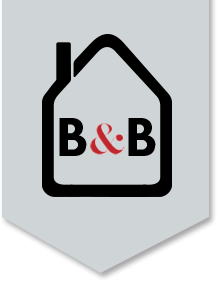Sustainability
What is sustainability? How does it affect me? What does it have to do with tiny living?
What is sustainability? How does it affect me? What does it have to do with tiny living?
You’ve seen beautiful tiny houses on wheels on TV, in magazines, and on the internet. You could see yourself buying a tiny house one day. You could use it for vacations, put it in your backyard to use as a studio or guest house, or you could live in your tiny house full-time.

In this photo: The Hoosic Tiny House
But you may have asked yourself: if it’s on wheels, how does it really work? How do you get power to a tiny house? How do you get fresh water in and waste water out? How are tiny houses climate controlled? What expenses are you forgetting to include in your overall budget?
There’s a lot more to buying a tiny house than just buying the tiny house. You’ll need to have a good understanding of how it all works, and how you’ll deal with fresh water, waste water, power, and parking. There are many options for different types of tiny house setups. Before building, your builder will need to know how you plan to use your house so he or she can help you choose the best appliances and systems for your specific situation. Read about tiny house design sessions.
Because they’re on wheels, tiny houses can travel. However, life on the road isn’t for everyone: most tiny house dwellers live in one place with permanent utility connections.
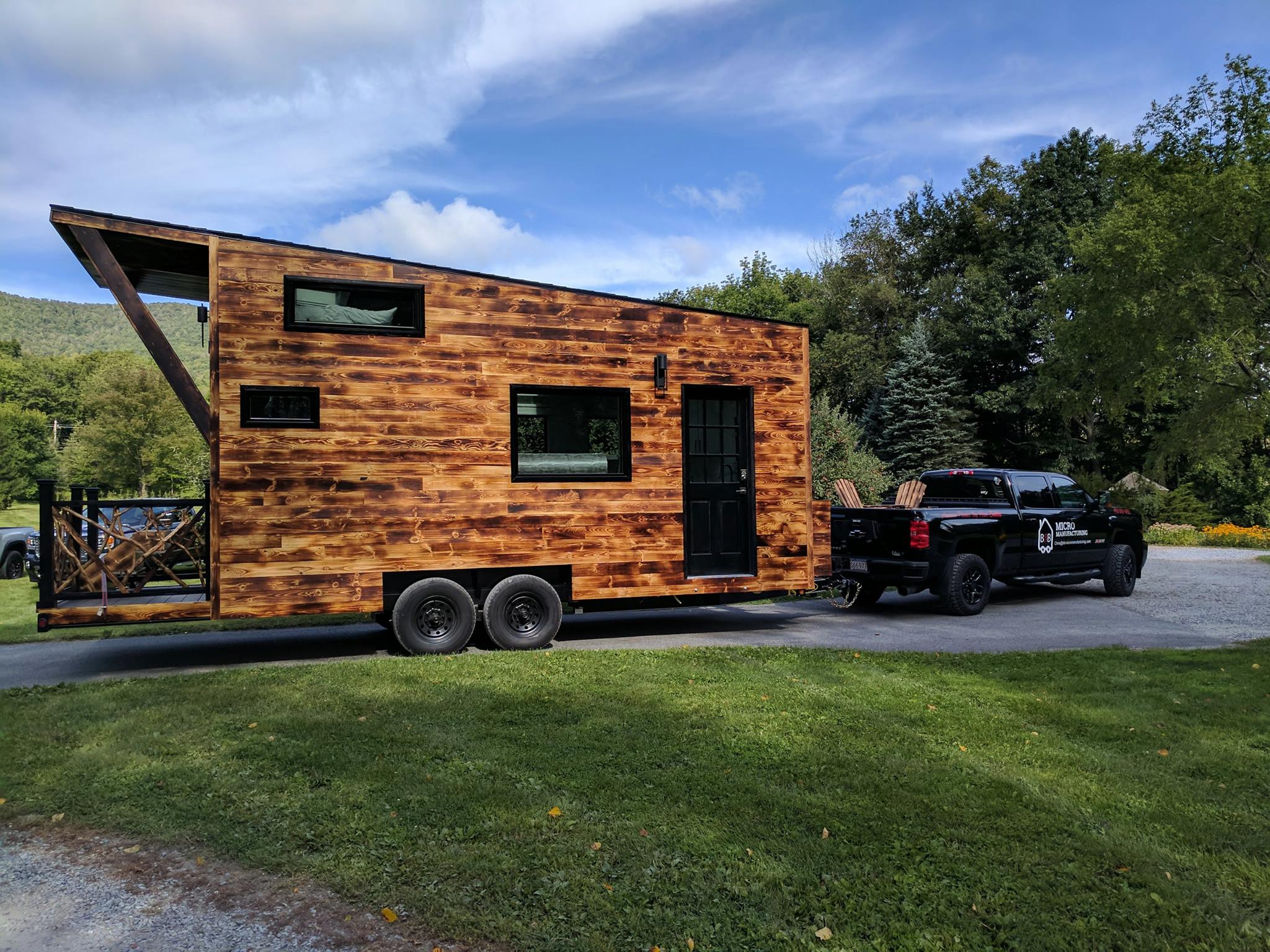 If you’re traveling with your tiny house:
If you’re traveling with your tiny house: If your tiny house will stay in one place:
If your tiny house will stay in one place:Most people place their tiny house on a gravel or concrete pad. This keeps utility lines in place and systems working properly (for example, some mini splits can leak if they’re not level).
Anchors are a great idea: they’ll keep your house from shaking even in the worst weather.
Skirting, while not necessary, also reduces shaking in high winds, and, if insulated, helps keep your pipes from freezing. Skirting creates a more permanent look to your tiny house.
If you don’t have a location for your tiny house yet, here are some things to consider when looking:
If you’ll be placing your tiny house in a backyard, here are some tips:
Photos in this section: The Arcadia Tiny House and the Spectacle Tiny House (a custom-built park model that’s not in our catalogue).
When people envision life on the road, they picture a life of freedom. But if you’re a human, you’ll still need water for life’s basics: drinking, cooking, and bathing.
For water, RV hookups come standard on B&B Tiny Houses. RV hookups have an inlet for a fresh water hose and an outlet for waste water. You can connect the hoses to a hookup pedestal at an RV park or, if your tiny house is in a backyard, to the main house.
Tiny houses on wheels have four potential spaces where water is used: kitchen sink, bathroom sink, shower or bath, and toilet. Depending on whether you’ll be traveling or staying put, and what systems are available at your location, we’ll help you decide on the best type of toilet for your lifestyle.
If you’re traveling, here’s how to hook up your tiny house at a campground:
Some tiny houses have water tanks and some don’t. If you’ll always be hooked up to a water system when you’re using water, you won’t need water tanks.
If your tiny house has water tanks, the tanks can store fresh and waste water until your house gets to a pumping station.
If you have water tanks, here’s a video on how to empty waste water (black water) tanks at a dumping station.
If your tiny house is staying in one place, you’ll want a more maintenance-free water system. Tiny houses on wheels can be hooked up permanently to the same systems traditional houses use: a well or city water for fresh water, and septic or sewer for waste water.
If your tiny house is in the back yard of a traditional house, you can hook your tiny house up to the existing water system, as long as it has the capacity to add another “bedroom”, which is code for “the water usage equivalent of one or two people being added to a house”. Generally, when houses are built, the water system permits the house to add at least one extra bathroom, in case the house gets an addition in the future.
Generally, we advise our customers not to DIY sewer connections, as there’s too much that can go wrong. However, we want you to have an understanding of how it’s done, so please watch the following video of how one DIYer connected his RV to the sewer.
Power is the second most important utility your tiny house will require. If it’s good weather outside, you can survive without using power, as if you’re going camping. But if you want to take a hot shower, operate lights and other electronics, and generally live like a modern human, you’ll need a constant source of power going to your tiny house.
 Most tiny houses on wheels come with RV hookups where you plug an extension cord with an adapter into the side of your house.
Most tiny houses on wheels come with RV hookups where you plug an extension cord with an adapter into the side of your house.
We hope this explanation of the many ways to set up your tiny house was helpful. In your design session, we’ll ask you to describe what your living situation will be and we’ll go over the best options for your specific situation.
Here’s an article that walks you through the 8 steps of buying a tiny house. When you’re ready to buy your tiny house, contact us to get started!
Thank you to YouTubersSean and Kristie Michael of Long Long Honeymoon, Mark Rowles, and BuckWSR for their instructional videos.
The tiny house amendment has gone through all the previous stages of approval: registered voters in Great Barrington will vote on whether to allow them at the annual town meeting on May 6.

Katie Jackson of B&B Tiny Houses was asked to do a presentation at a planning board meeting on what tiny houses are, how they work, and how other cities have written them into their zoning code. Katie is also the Northeast Regional Director of the American Tiny House Association, which is hosting the open house on May 5.
Here’s our previous update on Great Barrington’s consideration of allowing tiny houses on wheels.
Here’s an article on Great Barrington’s Town Meeting from the Berkshire Edge.
Backyard tiny houses will add density without having to change the infrastructure of the town; it’s the quickest, easiest solution (and one of many) that will address the housing crisis.
Here’s Great Barrington’s proposed zoning language pertaining to tiny houses:
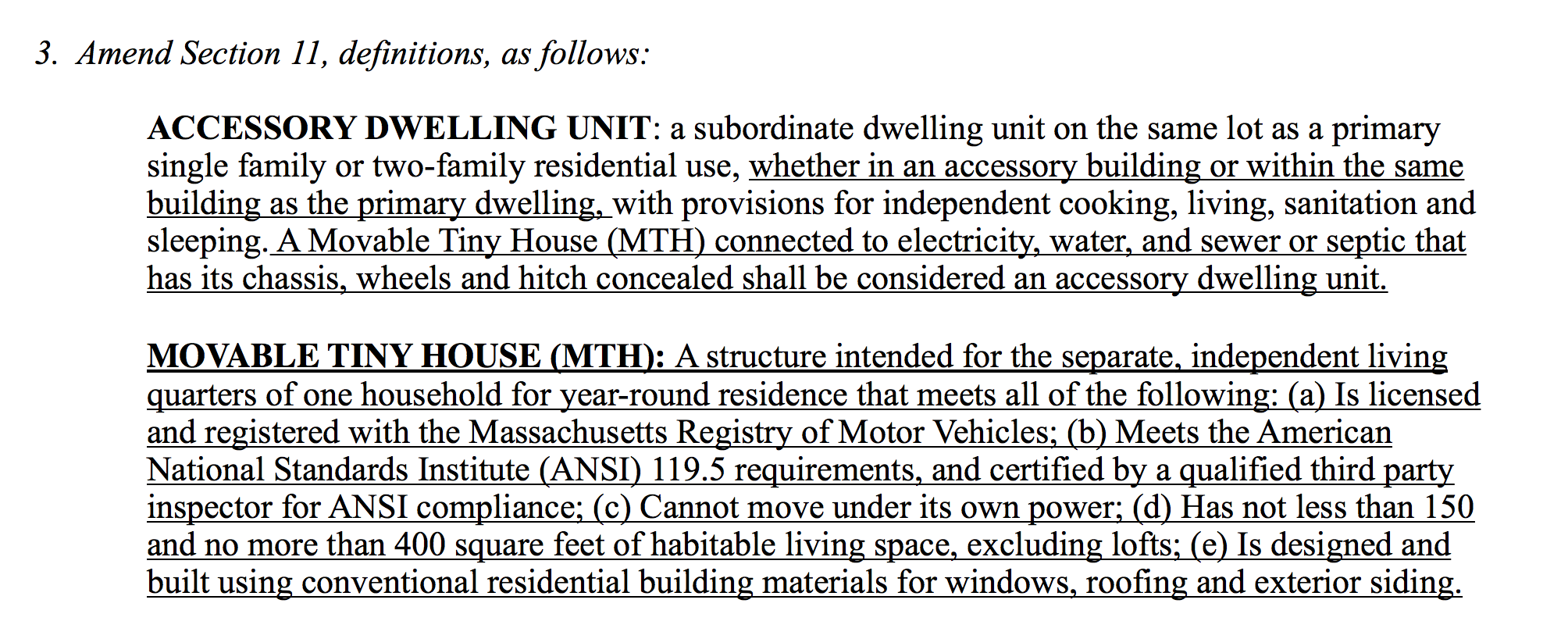
Acronym Key:
MTH: Movable Tiny House
THOW: Tiny House on Wheels
ADU: Accessory Dwelling Unit
-Tiny House Open House in the backyard of 65 Anderson Street, Great Barrington, MA 01230. Sunday, May 5, 10am-4pm.
Sunday’s tiny house open house is in advance of Monday’s Great Barrington Annual Meeting, where a proposed zoning amendment allowing Movable Tiny Houses as accessory dwelling units will be voted upon, among other topics. The open house is hosted by Amy Turnbull who is on the leadership team of the American Tiny House Association, with a movable tiny house built by Tony Indino of East Granby, Connecticut (this house is shown in the event flyer). This open house will give a glimpse into what backyard tiny houses might look like in Great Barrington if the Movable Tiny House Amendment passes.
-Great Barrington Annual Meeting & Vote at Monument Mountain High School Auditorium, 600 Stockbridge Rd, Great Barrington, MA 01230. Monday, May 6, 6:00pm.
Please attend the Annual Meeting on Monday in support of allowing movable tiny houses in Great Barrington backyards. The proposed amendment language is posted in the comments. All those who are registered to vote in Great Barrington may vote on the amendments.
Off-grid living has been growing in popularity in recent years. There are different interpretations of what off-grid living is; however, generally, 0ff-grid living implies that where you live is not connected to the electrical grid. This means that people that live off-grid must use some form of renewable energy if they wish to have electricity. In addition, it usually means that they are not connected to the municipal water supply. Because of this, it’s apparent that off-grid living presents some challenging circumstances; however, becoming one step closer to being fully self-reliant is highly rewarding to some.
There are many reasons why people choose to live off-grid. It can be a great opportunity to try something new and disconnect–even if the city’s power goes out, you will still have power! In addition, over time you will save money on electricity bills; however, renewable energy, like solar panels, can have a high initial cost.
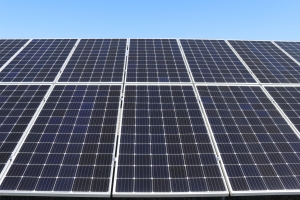
It is also worth mentioning some of the drawbacks of off-grid living. The upfront cost of solar panels and extra effort required to ensure that you are allowed to be off-grid on your land are important considerations.
Admittedly, there are different ways to live off-grid. When figuring out the right option, you should take into consideration how your tiny house will get power and water. You can use a generator or solar panels for power. For water, you either have the option of bringing the water to your property and holding it in tanks built into your tiny house or building a water collection tank from rainfall (this option isn’t likely to keep enough water on hand for typical consumption). Living off-grid is completely feasible in a tiny house; however, it requires additional planning. If you would like more information on off-grid living, send us a message through our contact page!
The tiny houses built by B&B Tiny Houses are well insulated and sealed. This works great for keeping the inside warm in the winter and cool in the summer, but it means the air inside can get stale.
HRVs, or Heat Recovery Ventilators, control a home’s humidity, reduce indoor mold and mildew, and exhaust stale, polluted air. Unlike traditional vent fans, however, HRVs recover some of the warmth that’s being exhausted to the outside in the winter time, while removing the pollutants and moisture to ensure that the fresh air coming in is still warm. Maintaining the temperature of the air while exchanging stale air for fresh air cuts down on the cost of heating a home.
The HRVs we use in our tiny houses come in pairs, where units are placed on opposite walls and air flow is transferred back and forth. In a tiny house, only one pair is necessary, because it’s such a small space. Each unit is installed directly on an exterior wall, so no ductwork is needed. Even when the door to, say, the bathroom is closed, it’ll still work because we leave a 3/4″ space beneath the door in tiny houses with HRVs. They are turned on and off by a switch.
From the 475 Lunos e² HRV website:
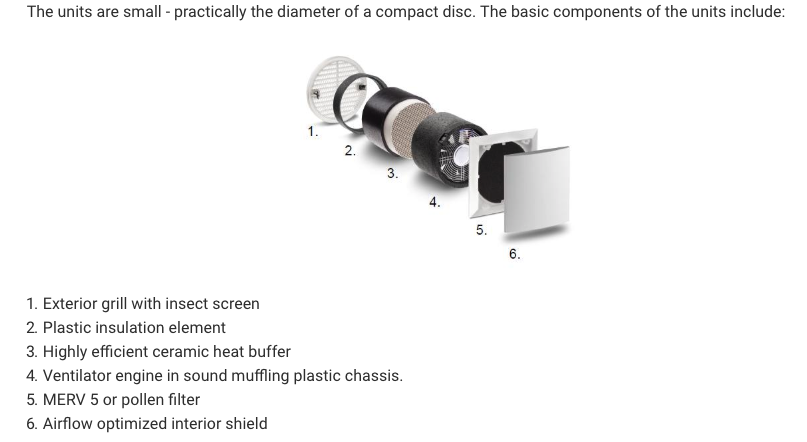
#6 in the photo is the part you’ll see on the interior wall of your tiny house. #1 is what you’ll see on the outside of the tiny house.
Where should HRVs be used?
Heat Recovery Ventilators are for use in the USA’s northern states. Energy Recovery Ventilators (ERVs) are to be used in the southern states.
Does an HRV warm or cool the house?
No; it maintains the inside temperature, rather than sucking all the heat or cool out of house.
Is it loud?
The system contains a sound muffler. It produces 0.12 sones at its lowest setting while a quiet refrigerator in a quiet kitchen produces about 1.0 sones.
Do I really need an HRV in my tiny house?
There are a few factors to consider when deciding whether to spring for an HRV. The type of HRV we use costs around a few thousand dollars, so it’s worth spending the time to decide whether you really want one in your home.
Factors to consider include:
What if I don’t use an HRV?
It’s important to not let mold and mildew build up from the moisture created by your bathroom and kitchen. But if you don’t have an HRV in your tiny house, there are other ways to get fresh air into your home. Our tiny house bathrooms come with a vent fan that goes on whenever the bathroom light is switched on. Vent fans will let the heat out of your house in the winter, but they are included with the basic model tiny houses and are much less expensive to install. You can also just open your windows periodically to let the fresh air in. All of our houses with a propane stove/oven also come with a kitchen range hood.
How do HRVs work?
This video explains how a heat recovery ventilator works. The example shown in the video is for a much larger house; the ones used in tiny houses look like white squares, CD case shaped attached to the wall at opposite ends of the house.
Williamstown, MA had its planning board meeting last night, discussing whether to allow backyard cottages and second apartments to homes in certain zones of town. It was a full house, with others who couldn’t get seats standing in the hallway.
In the photo, Amy Jeschawitz, Chair of the Planning Board, sits under the town flag, depicting Williamstown’s beloved 1753 House. The 1753 House was originally called a “Regulation House” by the early European settlers, who, in order to be considered land owners, had to build a house that was at least 15’ x 18’ and 7’ tall. At 270 sq ft, this would certainly be considered a “tiny house” by today’s standards!
The size of the detached ADUs (backyard cottages) in the current proposed bylaw would be limited to between 900 and 1200 square feet, determined by the size of the existing home and its lot.
Also addressed was allowing a second unit to an existing single family home, either within or added on to the existing building. These two bylaws would mean that a single unit property within certain zones could ostensibly turn into a three-unit property.
The planning board voted 3-1 in favor of recommending the proposed bylaws, with the additional restriction of a five year wait between adding a second unit to a property and adding a third.
The bylaws will now be taken to Town Meeting.
Read more on the meeting from iBerkshires: https://www.iberkshires.com/story/59488/Williamstown-Planners-Recommend-Dwelling-Bylaw-Amendments.html
Last week’s public hearing in Great Barrington, MA addressed using tiny houses on wheels as backyard cottages. (If you haven’t already seen it or need a refresher, refer back to this blog post).
After the meeting, I spoke with Jonathan Hankin who is the president of the Planning Board. Here’s his recap:
As a side note, the Massachusetts Attorney General, Maura Healey, visited the B&B Tiny Houses workshop last year and said, in front of many members of the press, that she feels tiny houses are a good affordable housing option. She has also signed the Nantucket, MA zoning bylaw allowing tiny houses, so we feel good about Atty. Gen. Healey signing Great Barrington’s as well.
-K. Jackson
Pictured from left: B&B Tiny Houses Owners Chris St. Cyr, Jason Koperniak, Mitch Bressett, and Massachusetts Attorney General Maura Healey outside the Arcadia Tiny House. Photo from iBerkshires.com.
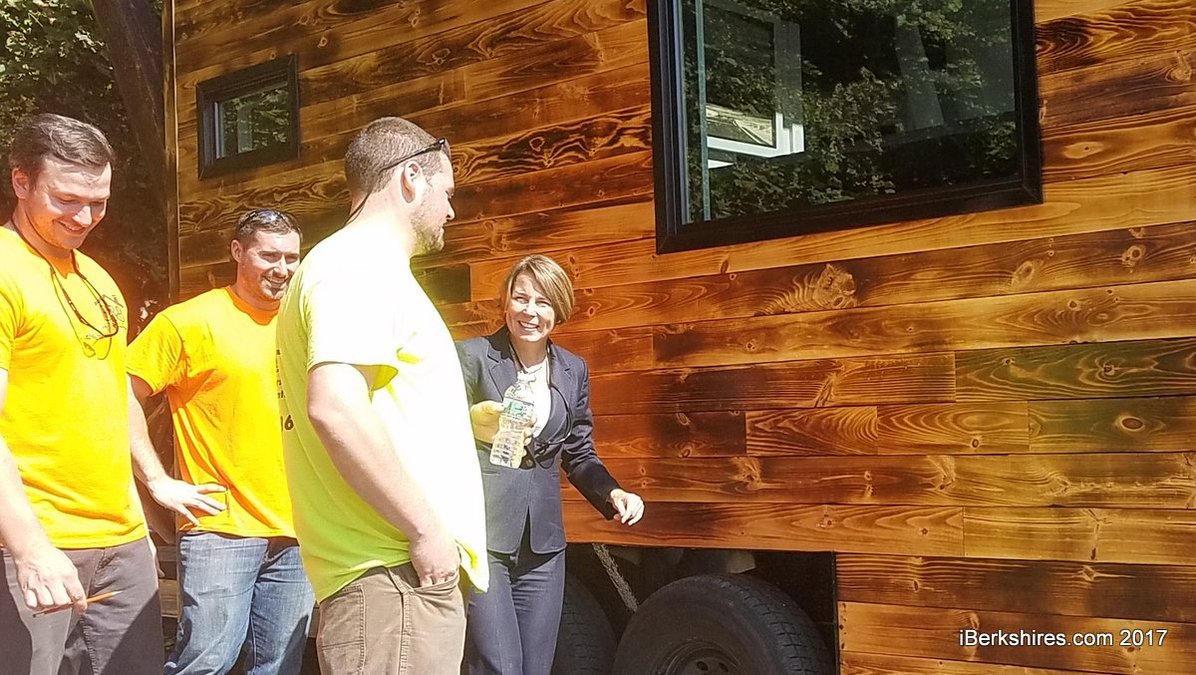
The Thursday meeting agenda includes a Citizen’s Speak Time, where those who live in Great Barrington can share their thoughts. Those who don’t live in Great Barrington but would like to show up in support of legal tiny houses may also attend the meeting.
This meeting will address movable tiny houses. Tiny houses that are on a foundation are already permitted as an ADU under the current bylaw and would need to meet the stretch code adopted by GB. The planning board is also seeking to increase the allowable number of ADUs to two.
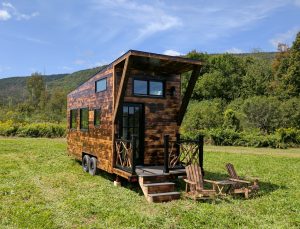
To Section 11.0 Definitions add:
Movable Tiny Houses (MTH)
A structure intended for the separate, independent living quarters of one household for year-round residence that meets all of the following:
(a) Is licensed and registered with the Massachusetts Registry of Motor Vehicles;
(b) Meets the American National Standards Institute (ANSI) 119.5 requirements, and certified by a qualified third party inspector for ANSI compliance;
(c) Cannot move under its own power;
(d) Has not less than 150 and no more than 430 square feet of habitable living space, excluding lofts;
(e) Is designed and built using conventional residential building materials for windows, roofing and exterior siding.
ACCESSORY DWELLING UNIT: a subordinate dwelling unit on the same lot as a primary single family or two-family residential use, with provisions for independent cooking, living, sanitation and sleeping. (Add) A Movable Tiny House (MTH) connected to electricity, water, and sewer or septic that has its chassis, wheels and hitch concealed shall be considered an accessory dwelling unit.
(This proposed language may have been updated by the time the meeting takes place).
Please attend:
Read the Meeting Agenda here.
Many tiny home owners chose to adopt the minimalist lifestyle in order to live more sustainably. Solar panels offer a great form of renewable energy, but there are many considerations that you will need to keep in mind before you decide if solar power is the right option for you. In this post, we will talk about the differences between grid-tied and off-grid solar power.
As the name suggests, grid-tied solar systems connect to a utility power grid.
Pros
– Net metering: Net metering is when excess energy created by your solar panels is sent to the utility power grid for others to use. This allows solar panel owners to be paid for the excess electricity that their panels create.
– On-grid Connectivity: If the solar panels do not create enough power for your tiny home, then the electrical grid will give electricity to your home as needed. This can allow a tiny home owner to buy solar panels in phases and increase the amount of panels their home relies on whenever the owner pleases.
– Affordability: Grid-tied solar power is the cheapest option for solar energy.
Cons
– Lack of Transportability: Many tiny home owners like to frequently move around with their tiny house. Because of this, a grid-tied system would not be the ideal choice because they might not have access to an electrical meter while on the move.
Off-grid systems are able to move with tiny home owners as they travel. Off-grid systems work by converting sunlight to power during the day and then storing this power in batteries for future use.
Pros
– Transportability: With this option, you are able to travel with your tiny home and have a source of power.
– On-grid connect-ability: There are off-grid options that can also connect to the grid, which enables tiny home owners to not have to worry about not having electricity and allows owners to sell back surplus electricity.
Cons
– Price: Compared to grid-tied systems, off-grid systems cost more money. In order to prevent a lack of power, most off-grid systems are oversized to make sure that there are no outages; this usually takes into consideration 1-2 days without solar panel generation.
– Lack of Electricity: Solar panels may not produce enough electricity due to weather or because your tiny home is using more power than predicted. As discussed above, this is why most off-grid systems are oversized. Tiny home owners do have the option of charging the batteries via a generator if there is not enough solar power produced.
Depending on how you are wanting to use your tiny home and budget will probably be most tiny home owners’ biggest considerations when deciding which solar system to opt for.
Learn more about our process or fill out the form below and one of our tiny house experts will reach out to you.
